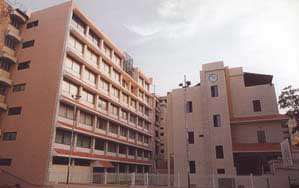Haigazian University
Lebanon http://www.haigazian.edu.lb/HISTORY & VISION

Haigazian University is named in honor of Dr. Armenag Haigazian, former headmaster of the Jenanian Apostolic Institute of Konya,Turkey. Dr. Haigazian was a highly respected educator who received his Ph.D. from Yale University and returned to Turkey to serve his Armenian compatriots. When the "ethnic cleansing" of the Armenians began, Dr. Haigazian had the opportunity to escape to the United States, but he chose to stay and continue his ministry. Later, he, along with the Armenian intellectuals, was rounded up to be driven to theSyrian Desert. Dr. Haigazian died on the way in the prison of Kharpert in 1921. Concurrently, eight Armenian colleges were also destroyed in Turkey. Although these realities of education and service were brought to an end, the dream continued in the minds of Dr. Haigazian’s descendants and others. The Mehagian family (Mary Mehagian and Florence Mehagian-Guertmenian) of Phoenix, Arizona, relatives of Dr. Haigazian, donated capital through the AMAA and worked hand in hand with Stephen Philibosian to get Haigazian College started.

Dr. Armenag Haigazian
The University was founded on October 17, 1955, by the Union of Armenian Evangelical Churches in the Near East (UAECNE) and the Armenian Missionary Association of America (AMAA) as a liberal arts college to assist in the preparation of teachers and pastors.
Prior to this date, the Armenian Evangelical community of Beirut, to complement its high schools, had established two post-secondary educational entities: the Teacher’s Training Institute, which was housed in the library of the Central High School and operated from 1948-51, and the Armenian Evangelical College, which held a Freshman Arts and Sciences program under the sponsorship of the First Armenian Evangelical Church of Beirut. These two entities merged in 1951 forming a Freshman Arts and Sciences plus a Sophomore Arts program, and they continued to serve the Armenian Community until 1955, whenHaigazian College was established. Haigazian College was originally designed to function as a junior college offering two years of university-level education. However, a demand for upper-division classes encouraged the institution to develop fouryear programs.
In 1987, due to the war, the University moved to the Christian Medical Center in the Ashrafieh district, and classes continued as usual. On March 27, 1996, the Board of Managers decided that the University should return to its original campus on Rue Mexique, Kantari. OnFebruary 16, 1997, the renovation of the former campus began. OnOctober 6, 1997, classes resumed in the renovated and revitalized Kantari campus to the delight of students and the community at large.
FacultiesFaculty of Business Administration and EconomicsBusiness Administration & Economics
Accounting Advertising & Communication Finance Legal Studies Management Information Systems Business Administration Hospitality Management Diploma Hospitality Operations Certificate Economics Economics Hospitality Management Hospitality ManagementMaster of Business Administration Program General MBA Accounting Accounting Management MarketingFaculty of HumanitiesDepartment of Humanities
Arabic Armenian Studies English Literature History Music TEFLFaculty of Sciences
1. Division of Natural Sciences
Biology Chemistry Medical Laboratory Sciences2. Division of Mathematical Sciences
Computer Science Mathematics Physics Libraries
TheHaigazian University libraries consist of the Barsoumian Library (English and Arabic) and the Armenian Library.
Collections
The basic collection of the libraries was built up through cash donations or books from generous donors. Since 1962, in addition to donations and exchanges, the Haigazian University administration has been allocating a special budget for the purchase of books and periodicals each year.
The Barsoumian Library’s collection comprises around 35,000 volumes, including an Arabic collection, and 3,213 volumes of bound periodicals. The library currently receives 168 periodicals. It also houses the special collection of Dr. Armenag Haigazian’s archives, which includes academic notes, textbooks on diverse subjects, and a pocket encyclopedia in Armenian.
The Barsoumian Library uses the Library of Congress Subject Headings and the Dewey Decimal Classification. The library aims at supporting and supplementing the general curriculum of the university. It offers the reader spacious reference/reading rooms, microfiche readers/printers, photocopy machines, and computers with Internet access.
The Armenian Library contains a collection of about 31,787 volumes, including 5,751 volumes of bound periodicals. It subscribes to 136 current periodicals. In a short time the Armenian Library succeeded in establishing its own department, its own staff, and the best facilities for its users. Under the special care of both the College Administration and the Armenian department, Mr. Jirair Tanielian, bibliographer, scholar and first librarian from 1965-1987, a very valuable collection of books and periodicals devoted to Armenian Studies was acquired.
The Armenological Library is considered to be one of the best organized and richest collections in the diaspora. Its book collection includes a number of rare books and a selection of 18th and 19th century publications. One of the oldest books in the collection is a copy of the first Armenian Bible published in 1666 inAmsterdam by Voskan Yerevantzi. Of special interest are books in Turkish, but written in the Armenian Alphabet (Hayadar Trkeren). The library also has special collections of coins, playbills, posters and paintings. During the last twenty-five years special attention has been devoted to collecting books in foreign languages (Arabic, English, French, German, Italian, Russian, etc.) related to Armenian Studies.
The periodical holdings include many complete collections of 19th century journals such as Bazmaveb (Venice, 1843-), Handes Amsorya (Vienna, 1887-), Arevelian Mamoul (Smyrna, 1871), Meghou (Constantinople, 1856), Hairenik (Constantinople, 1891), Mourj (Tiflis, 1889), Sion (Jerusalem, 1866), and Shdemaran Bidani Kideliatz (Smyrna, 1839).
Until 1975 the library maintained regular contacts with local and foreign Armenological libraries, institutions, and scholars. These contacts, which were disrupted by the civil war in Lebanon, are gradually being resumed. The Armenian Library, a rich resource center, provides services to Haigazian students, faculty, and the community at large.
In order to enhance the learning experience of students, the University libraries have enriched their collections by adding microfiches (3,855), maps (280), audio-visual materials (1,286), sound recordings (695), videos (685), pamphlets (560), clippings (10,347), etc.